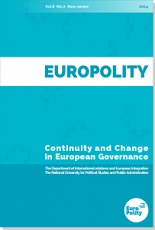BENEFICIARIES OF THE SECOND ORDER ELECTION MODEL: RADICAL RIGHT PARTIES IN THE EUROPEAN PARLIAMENT
BENEFICIARIES OF THE SECOND ORDER ELECTION MODEL: RADICAL RIGHT PARTIES IN THE EUROPEAN PARLIAMENT
Author(s): Luiza Maria FilimonSubject(s): International relations/trade, History of European Union
Published by: Scoala Nationala de Studii Politice si Administrative (SNSPA)
Keywords: Dansk Folkeparti; European Parliament Elections; Front National; Radical Right Parties; Second Order Model
Summary/Abstract: After the latest European electoral cycle, right wing parties on the far side of the political spectrum along with right-wing euro-sceptics and conservative anti-federalists won 112 seats. The presence of the radical right in the European Parliament (EP), has often been attributed to the second order election model theorised by Reif and Schmitt (1980). In European elections, turnout is traditionally lower compared to “first” order national elections, parties in government tend to lose vote-shares while smaller parties benefit from the European system of proportional representation. This article analyses the relationship between radical parties and the EP by examining the French and Danish results in the 2014 elections. Though both constitute the third political force in their countries at that time, Front National and Dansk Folkeparti’s electoral support is representative of a second order election. The former party benefited from a classic sanction vote while the second one owes its breakthrough to a particular Danish voting behaviour, somewhat singular in the European Union. The article offers an in-depth overview of the literature on both the radical right, the Second Order Election model as well as radical right parties’ dynamic at the European Parliament level.
Journal: Europolity - Continuity and Change in European Governance
- Issue Year: 9/2015
- Issue No: 2
- Page Range: 193-223
- Page Count: 31
- Language: English

